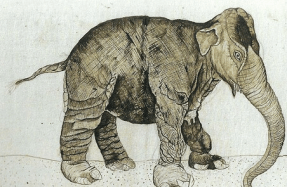RE-INTERPRETING THE LOST CHOIR OF DUNFERMLINE ABBEY: HISTORY, LITURGY AND GROUND - PENETRATING RADAR

During our GPR fieldwork and research (2016-19), two themes were repeatedly underlined. First, the dangers of seeking a neat, consistent pattern of architectural and liturgical development in such a complex lost building as Dunfermline Abbey; and second, most important of all, the need to take account of the high level of disruption and reuse inflicted upon the choir site during the ‘Psalter’ period 1560-1818. These were generations which saw the ruinous choir site occupied periodically by everything from Cromwellian troops to stone auctions following wall and tower collapses, as well as by town burials.
In that context, for reasons discussed below, we should set aside the 1818 ‘Bruce grave’ from our discussion of the medieval altar area from the outset. The paved sanctuary/chancel spaces of high-status churches of the 12th and 13th centuries sought to exclude elite lay burial within their bounds unless for figures who might be considered saintly (as were Malcolm III and David I by Dunfermline’s monks). As leading theologian William Durandus of Mende (1230-c.1296) advised, long, low sanctuary steps should symbolise the apostles, martyrs and virtues and:
No body should ever be buried in a church, near the altar, where the Body and Blood of the Lord are confected, unless they are the bodies of Holy fathers whom we call patrons, that is, the defenders of the church, who by their merits, defend the entire religion.

Above all this would have left the high altar, the mass and communion visible from choir crossing space and the monks’ stalls further west. One or more railed box tombs (like Bruce’s) would surely have blocked such a view at Dunfermline. Moreover, the effigies, heraldry and inscribed epitaphs of these tombs would not have been visible at all to most visitors.
That Dunfermline’s lost choir high altar sanctuary conformed to these principles may be partly confirmed by our GPR. Rather than being evidence of medieval or ‘Psalter’ burials, the distinct features identified in our central scans may represent footings of the screening and altar setting of the post-1250 church fittings which had reused the David I-era apsidal east end of his original choir.
Significantly, there is previously overlooked antiquarian evidence which further confirms these possibilities. Local historian Ebenezer Henderson (1809-79) deposited (1879) in the town’s Carnegie library. It contains unpublished measurements for the four base stones of the high Trinity altar (based in turn on pacing by Edinburgh surveyor, John Baine, in 1790). These accounts prove that there were further choir remains extant in 1818 than otherwise made known to the public.
You’re reading a preview, subscribe to read more.
Start your free 30 days



